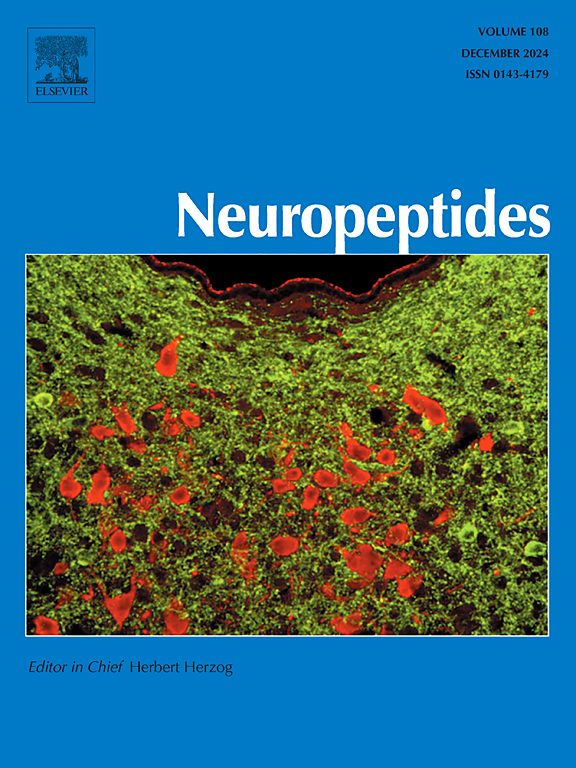唾液神经紧张素和催产素在应激接种的情绪反应中的作用
IF 2.7
3区 医学
Q3 ENDOCRINOLOGY & METABOLISM
引用次数: 0
摘要
神经肽包括一类信号分子,对靶组织产生直接作用,并对多个生理系统产生调节作用;然而,它们在介导应激反应中的作用尚未完全确定。先前的研究表明,急性应激会改变唾液中神经肽的水平,但这些改变在多大程度上与应激接种和情绪效价的机制有关,还需要探索。本研究旨在探讨军医学生急性应激后唾液神经肽与情绪效价的关系。研究人员收集了应激接种前后参与者唾液中催产素、神经紧张素的样本,以及ACE和SPANE两份问卷的数据。Spearman秩相关分析显示接种前后神经紧张素和催产素呈正相关>;0.9。接种后神经紧张素与模拟前span - p和span - b评分呈负相关(p = 0.006和p = 0.009),与模拟前span - n评分呈正相关(p = 0.043)。接种后催产素与接种前span - p和span - b评分呈负相关(p = 0.007和p = 0.006)。建立了接种期间神经肽水平升高或降低的参与者的队列。催产素增加组模拟后的催产素与spane后的积极情绪呈负相关(R = - 0.4607),催产素减少组模拟前的催产素与spane前的积极情绪呈负相关(R = - 0.4005)。唾液神经肽对接种反应的个体差异与积极影响呈负相关,表明这些神经肽是情感应激反应的调节剂。未来的研究应该探索这些关联的机制,并评估唾液神经肽作为情绪和应激适应生物标志物的潜力。本文章由计算机程序翻译,如有差异,请以英文原文为准。
The role of salivary neurotensin and oxytocin in emotional responses to stress inoculation
Neuropeptides comprise a class of signaling molecules that exert direct effects on target tissues and modulatory influences across multiple physiological systems; however, their roles in mediating stress responses remains incompletely characterized. Previous studies have shown that acute stress alters salivary levels of neuropeptides but the extent to which these alterations are associated with mechanisms of stress inoculation and emotional valence requires exploration. This study aimed to examine the relationship between salivary neuropeptides and emotional valence following acute stress in military medical students. Salivary samples for oxytocin, neurotensin and data from two questionnaires, ACE and SPANE, were collected from participants pre- and post-stress inoculation. Spearman rank correlation analysis revealed positive correlations >0.9 for neurotensin and oxytocin at pre- and post-inoculation. Post-inoculation neurotensin showed an inverse correlation with pre-simulation SPANE-P and SPANE-B scores (p = 0.006 and p = 0.009 respectively) and demonstrated a positive correlation with pre-simulation SPANE-N score (p = 0.043). Post-inoculation oxytocin demonstrated a negative correlation with pre-inoculation SPANE-P and SPANE-B scores (p = 0.007 and p = 0.006 respectively). Cohorts were established of participants whose neuropeptide levels increased or decreased during inoculation. Inverse correlations existed between oxytocin post-simulation and post-SPANE positive emotions in the increased oxytocin group (R = −0.4607), and between pre-simulation oxytocin and pre-SPANE positive emotions in the decreased oxytocin group (R = −0.4005). Individual variability in salivary neuropeptide responses to inoculation was inversely associated with positive affect, suggesting these neuropeptides as modulators of affective stress responsivity. Future studies should explore the mechanism of these associations and evaluate the potential of salivary neuropeptides as biomarkers for emotional and stress adaptation.
求助全文
通过发布文献求助,成功后即可免费获取论文全文。
去求助
来源期刊

Neuropeptides
医学-内分泌学与代谢
CiteScore
5.40
自引率
6.90%
发文量
55
审稿时长
>12 weeks
期刊介绍:
The aim of Neuropeptides is the rapid publication of original research and review articles, dealing with the structure, distribution, actions and functions of peptides in the central and peripheral nervous systems. The explosion of research activity in this field has led to the identification of numerous naturally occurring endogenous peptides which act as neurotransmitters, neuromodulators, or trophic factors, to mediate nervous system functions. Increasing numbers of non-peptide ligands of neuropeptide receptors have been developed, which act as agonists or antagonists in peptidergic systems.
The journal provides a unique opportunity of integrating the many disciplines involved in all neuropeptide research. The journal publishes articles on all aspects of the neuropeptide field, with particular emphasis on gene regulation of peptide expression, peptide receptor subtypes, transgenic and knockout mice with mutations in genes for neuropeptides and peptide receptors, neuroanatomy, physiology, behaviour, neurotrophic factors, preclinical drug evaluation, clinical studies, and clinical trials.
 求助内容:
求助内容: 应助结果提醒方式:
应助结果提醒方式:


